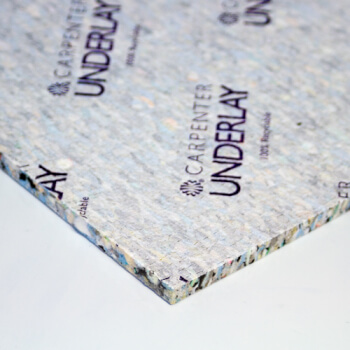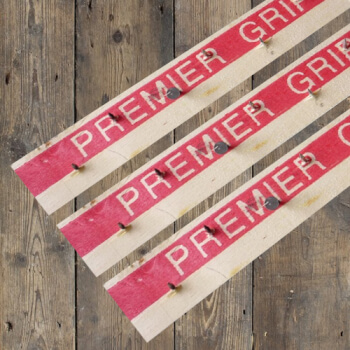Carpet and Culture - 4 Stories From Around The World
By Jim (05/12/2016)
We have already looked into the issue of how culturally important carpet has been throughout the ages, from the Berbers of North Africa to the prayer rugs of the Ottoman Empire, but there are still some interesting points we haven’t covered. Here we have another treasure trove of facts to prove - once again - that carpet is far more interesting that one might suppose...
1. The Flag of Turkmenistan
Turkmenistan is a country situated in the Central Asia, It hasn’t had much of an outing on the world stage of late, due to it’s ‘permanently neutral’ stance on conflict and its closed, nationalist policies - however, it was immensely important during the days of the Silk Road, the vast trade route which stretched from China all the way across Russia and into Europe.
Positioned as it is, north of Iran (then Persia) and Afghanistan, south of Kazakhstan and Uzbekistan and with the Caspian sea to the West, it could trade with many other nations.
And its main export? Carpet!
Carpets have been a key part of the Turkmen culture for centuries - the people were traditionally nomadic, divided into several tribes, with each tribe having its own unique ‘guls’ or medallion-like motifs woven into their products - this became similar to the coats of arms and crests in Europe, symbols of their heritage and history.
These became a valuable commodities to their neighbours as well as domestically, meaning they produced wealth as well as being culturally important.

Image: Flag of Turkmenistan, Source: FlagPedia
In fact, carpet was so much a part of national identity that when Turkmenistan redesigned its flag in 1992 (after declaring independence from the Soviet Union) it displayed five guls, representing the five most prominent tribes of Turkmenistan - Teke, Yomut, Arsary, Chowdur and Saryk.
This makes it the most complex and detailed flag in the world - and certainly more interesting than the one they had under the USSR!
2. Magic Carpet
Magic carpet? Everyone knows that idea comes from Aladdin! Except of course that things are always more complicated than they seem, especially when we’re talking about stories. A flying carpet doesn’t appear in the oldest version of Aladdin we have (collected and translated by Antoine Galland in 1709, who also incorporated it into ‘The 1001 Nights’, although it was not originally part of the tales).
Aladdin does contain a flying bed - or rather, a bed which is lifted and carried by the Genie (or djinn) of the Lamp, but no flying carpet. In later versions of the 1001 nights, there is a flying carpet, but in the story of the Sultan of the Indies (or 'The Three Princes') rather than Aladdin.
In both Jewish and Muslim traditions, King Solomon was supposed to have a huge flying carpet, big enough for his whole court of 40,000 to join him.
In some versions this flying carpet is a gift from the Queen of Sheba, made by her court alchemist who discovered, apparently, that a secret to making a carpet fly was to colour it with a special dying process. In other versions it was given to Solomon directly by God, and held aloft not by its own power but by a ring Solomon possessed which gave him power over the four winds.
In this story, Solomon’s pride grows until he declares himself master of the world - God warns him against this and, in certain tellings, punishes him by shaking his 40,000 men from the carpet and letting them fall to their deaths.
There is even mention of flying carpet in Russian Folktales, often being used by the witch Baba Yaga or Ivan ‘the fool’ (the equivalent of ‘Jack’ in western folktakes). The truth is we don’t have an original literary source for the idea of the flying carpet - it’s just one of those things which seems to have stuck in people’s heads.
NB: An oft misattributed source in this area is ‘The Secret History of Flying Carpet’ by 13th Century Jewish scholar Isaac Ben Sherira, which claims that flying carpets were genuinely real- unfortunately, Sherira and his writings are purely fictional, creations of Pakistani Australian author Azhar Abidi!
3. The Great Carpet Quarrel

Image: Sir Arthur Sullivan
Source: WikiMedia Commons
Could a carpet destroy one of the greatest creative partnerships in the history of theatre?
Well, that’s the story…
In 1890, William Schwenk Gilbert and Arthur Seymour Sullivan were the toast of London society. They were working at the Savoy Theatre under the auspices of Richard D’Oyle Carte and had several hits under their belt. They were both successful and Sullivan already had a knighthood (Gilbert would also receive this honour somewhat later in 1907), but their collaboration was to come to an end over a seemingly trivial dispute.
During the run of their 11th opera, The Gondoliers, Gilbert took exception to the fact that Richard D’Oyly Carte had spent £500 on a carpet to be deducted from the profits of the show - from which both Gilbert and Sullivan also took their wages.
The carpet, however, was not for the show at all- it was for the front of house area at the Savoy itself.
Gilbert, always an austere and practical man, saw this as dishonest and the two had a fierce argument. Initially conciliatory, Sullivan eventually sided with Carte - not least because Carte was founding the Royal English Opera House, at which Sullivan's own serious Opera ‘Ivanhoe’ was to be staged.
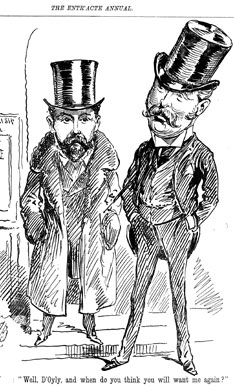 Barely a month after the initial row, Gilbert wrote to Sullivan, saying their partnership was at an end. The friendship was further soured when Gilbert took the matter to court over his share of the profits.
Although the two were briefly reunited in 1893, with two further light operas together, the spark of their previous works was gone.
Barely a month after the initial row, Gilbert wrote to Sullivan, saying their partnership was at an end. The friendship was further soured when Gilbert took the matter to court over his share of the profits.
Although the two were briefly reunited in 1893, with two further light operas together, the spark of their previous works was gone.
At least, that is the generally accepted version.
In reality, it was slightly more complex.
Sullivan was already frustrated with having to accommodate Gilbert’s writing rather than expand his own musical talents.
Gilbert had felt for a long time that he and Sullivan did not really need Carte, and that he was holding them back by making poor decisions. Carte, for his part, felt poorly treated by Gilbert, who was never a man to hold back his temper and barbed wit - Carte’s wife said that the librettist treated his employer in a manner unworthy of ‘an offending menial’.
Carte himself always maintained that the figure Gilbert quoted of £500 was inaccurate, and it was in fact £140. Lastly, the carpet was only one of several things Gilbert found suspicious in Carte’s accounts - it just so happened the carpet was the most expensive.
Image: W.S. Gilbert & Richard D'Oyly Carte, cartoon by Alfred Bryan
Source: WikiMedia Commons
In the end the carpet was just the catalyst that brought tensions between the three men to the surface...but hey, never let the truth get in the way of a good story!
4. Carpet Speak
Where does the word carpet come from?
Well, unsurprisingly it was originally from Latin - carpere meaning ‘plucked’ (it is sometimes translated as ‘carded’, a process which you may remember from our last blog) - this evolved into the Old Italian carpita or plucked, coarse cloth.
The French ‘carpite’ just meaning decorated cloth, turned up in the 13th century - it was only 200 years later that ‘carpet’ switched to mean the thing we put on the floor.
This helps to describe some of the phrases we still have - for all you eager etymologists out there, here’s an example: “Called on the Carpet” (bear in mind that this is not ‘called onto the carpet’, or ‘called to the carpet’) - it to be summoned (usually by a superior) for a telling off.
But why?
Well, carpets used to be used for all sorts of things other than for the floor - we have already mentioned in another blog how they were used as wall-hangings - and one of their functions was to be draped over a surface much like a tablecloth - for diplomats and leaders, the important documents for signing would be ‘on the carpet’.
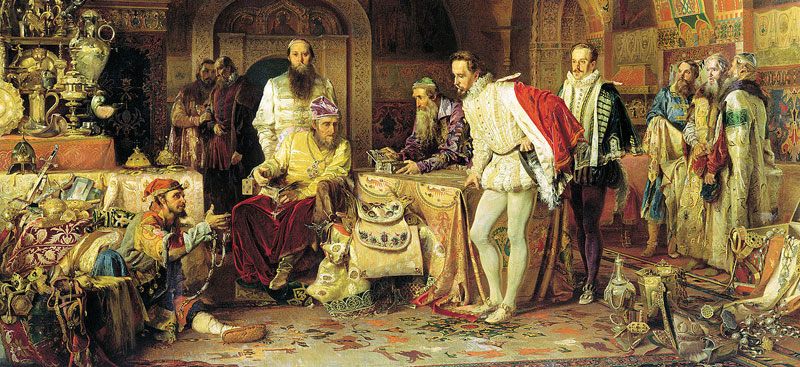
Image: 'Ivan The Terrible Showing His Treasures To Jerome Horsey' by Alexander Litovchenko (1875)
Notice the carpet adorning the table, another sign of Ivan's wealth -Holbein's The Ambassadors also uses carpet in this way.
Source: WikiMedia Commons
Calling is being used in this instance in the same way something is ‘called’ in an auction - the issue mentioned, raised, brought to attention. So when some matter of state was ‘called on the carpet’ it was an under scrutiny. As you can imagine, being someone who was themselves under scrutiny was not always a pleasant experience, and so it probably became synonymous with being in trouble.
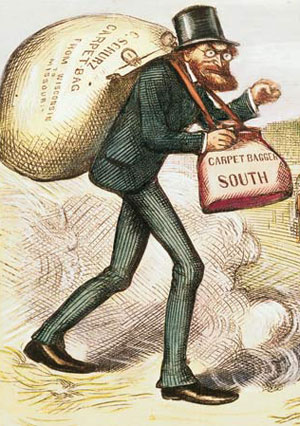 We have already covered the first literary use of ‘Red Carpet’ in one of our previous blogs, so we won’t go into it again - and ‘brushed under the carpet’ or ‘pull the rug out from under you’, are pretty self explanatory, but have you ever heard someone described as a ‘carpetbagger’?
This is a more recent American phrase, meaning a politician who comes to an area where they have no previous connections and tries running for government.
We have already covered the first literary use of ‘Red Carpet’ in one of our previous blogs, so we won’t go into it again - and ‘brushed under the carpet’ or ‘pull the rug out from under you’, are pretty self explanatory, but have you ever heard someone described as a ‘carpetbagger’?
This is a more recent American phrase, meaning a politician who comes to an area where they have no previous connections and tries running for government.
Originating in the 1860s, it was first used to mean a Northerner who moved to the South looking for work just after the Civil War with their possessions in a cheap ‘carpet bag’ (which were actually made of carpet in those days) - it became short-hand for an form of outsider opportunism, eventually changing to its modern meaning.
It is also used in the UK to mean anyone who joins (or infiltrates, depending on your view) a customer-owned(‘mutual’) business and arranges for it to become a publicly traded joint-stock organisation for their own profit.
We are aware that there are some other phrases regarding carpet and rugs...however, you won’t find them on this website.
Image: Politician Carl Schurz depicted as a carpet bagger by satirical cartoonist Thomas Nast
Source: WikiMedia Commons
Okay, well that’s enough for now! I hope you enjoyed this foray into the floors of the world - we’ll be back with more later on, but if you want some British carpet culture highlights in your home, then we have some lovely products from Brintons, Victoria and Westex - all jewels in the crown of Britain's carpet!
Enter your required size for our most accurate pricing and availability.








